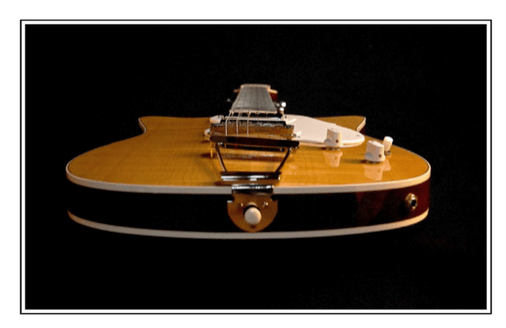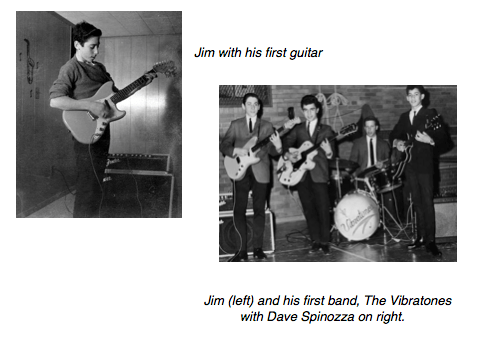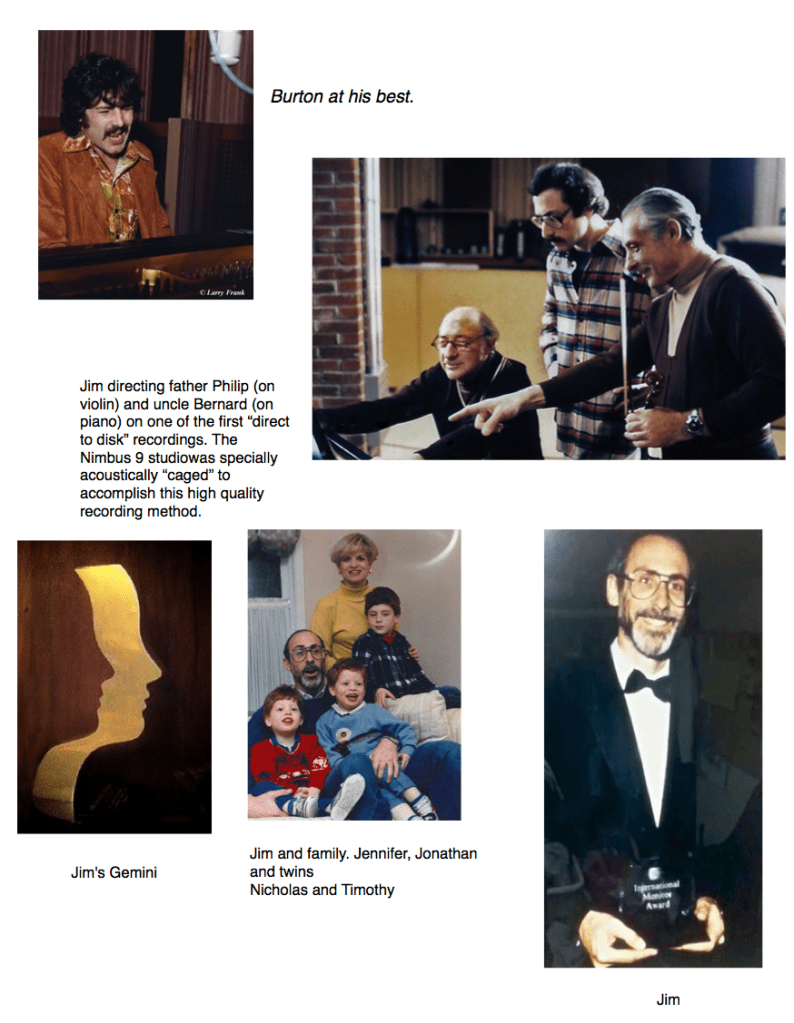A Tribute To My Brother Jim

He worked with John Lennon, Peter Gabriel, Bob Ezrin (The Wall/Pink Floyd), Alice Cooper, Bay City Rollers, Doctor John, Bob Seger, Burton Cummings/The Guess Who and many, many others.
Dateline: August 1957. Location: Living room, 17 Summit Avenue, Larchmont, a bedroom community in Westchester County, 22 miles north of New York City: When I heard the first three chords of “Wake Up Little Susie” by the Everly Brothers, I knew I had to become a guitar player.
Three weeks later I had a cheap acoustic flat-top. I learned those three chords by trial and error, and presto, I thought I was a guitar player.
Three months later, I stuffed a cheap microphone into the sound hole of that acoustic and ran it through the amplifier of my parents “hi-fi” set.
I thought I was an electric guitar player.
One month later, I somehow acquired a Gibson solid body electric.
Shortly thereafter, I achieved my dream. I was an electric guitar player in a rock n’ roll band, a bunch of well meaning guys who thought they could make music.
However, at around the same time, in the little town of Larchmont, there was another amazingly incredible rock band getting all the attention (in every sense of the word). I simply had to be a member of that band to achieve my dream.
Dreams sometimes come true, and in a short while, I had one blue and one pink tuxedo with the coveted “Orchids” crest embroidered on the lapel pocket. I was now an electric guitar player in that incredible rock band, The Orchids. Life was good.
My new music family consisted of Dick on piano and lead guitar (the only one with formal musical training), Ray on drums, Dennis on guitar (who subsequently quit) and soon to come, Eric on bass and Tommy on maracas doing very rough vocals, and “Barracuda,” our road manager and body guard (sometimes guys would pick fights with us in order to impress their girlfriends. “Cuda” would always fix those problems). In a subsequent addition to the Orchids, Bruce Bruno, an exceptional singer from a nearby town, would join. We all literally lived together when not in school. Bruce was such a talent that sometimes our band would be simply known as “Bruce Bruno.”
Little did I know that Bruce and I would become life-long brothers.
Then I saw Buddy Holly on TV singing his first hit, “Peggy Sue.” He was playing this amazing guitar, a Fender “Stratocaster.” By that time, the Orchids were actually making a few dollars playing small gigs and I had a few dollars in my pocket.
It seemed like forever to save $220 for a guitar just like Buddy’s, but I finally had the money after it seemed like an infinite amount of gigs. I had my “STRAT.”
In my high-school years, me and my rock n’ roll band must have played every local high school party, prom and dance. As our reputation spread, we eventually played gigs in bars in surrounding towns, then summer gigs at fancy upstate New York summer resorts, and eventually in New York City…at real clubs (we faked our ID’s so we could be over 18 to play in those bars and clubs). We even had a record and it was a thrill to hear it on the radio. You can’t imagine the high.
The band would most always practice in the basement of my Larchmont house. I will always remember my little brother Jim and sister Sally sitting at the top of the basement stairs listening to our band practicing, with specific instructions from my mother: DO NOT DISTURB.
I never suspected that my little brother, six years younger than me, would also want to be a guitar player. But, as the way it works, younger siblings tend to emulate their older siblings. Soon there was a second electric guitar making noise in the house.
As I woke up one late afternoon from a late night (or early morning) gig, I heard a guitar playing. I stumbled downstairs only to find my younger brother standing between me and the coffee pot…with his guitar in hand. This struck me as strange because the guitar playing continued to emanate from the basement.
I made my way to the sound, and to my horror, there was this young kid playing a guitar…my guitar…my Strat!
I just about lost it. My little brother came down to the basement as I was about to kill this kid. Jimmy asked me to calm down and give a listen. I did, and I realized that this little punk playing my Strat could really, really play. He was barely thirteen years old and played as good as any guitar player I had ever heard.
His name was David Spinozza and he was in “The Vibratones,” a rock n’ roll band with my little brother Jim. (Spinozza would go on to become one of the best studio musicians in the 60’s and 70’s, playing on albums for Simon and Garfunkel, John Lennon’s “Imagine” album and hundreds more).
I didn’t have much time for my brother’s musical activities as I was pretty busy with schoolwork, saving for a car and playing music with the Orchids.
But after playing hundreds of gigs, culminating with a giant stage show at the Brooklyn Paramount Theatre, doing three shows a day for a week with thousands in the audience for each show, with performers including Jerry Lee Lewis, Jackie Wilson, The Coasters, The Temptations, Dion and the Belmonts and more, I had a big decision to make.
The fork in the road was right in front of my eyes, and I think I made the right decision to leave music and head to university.
The band carried on and even played Las Vegas. Thereafter, various band members went on to other bands with million selling albums, including the “Young Rascals,” “Joey Dee and the Starlighters,” who created the famous “Peppermint Twist,” that gave Chubby Checker a huge meal ticket. Most of the former Orchids did well in the short run.
Tommy, our maraca player, sex symbol and an improving vocalist, on his way to super-stardom, was killed in an auto accident. Ray lost an eye in Viet Nam. Dick went on to become a successful lawyer.
And, believe it or not, Bruce, our lead singer, made his way with Canada’s very own super-group, “The Band.” As it happened, one night, Canada’s main rocker, Ronnie Hawkins, saw us at a club in New York City. Ronnie brought Bruce to Toronto to sing in his back-up band, The Hawks. However, Bruce later chose to leave The Hawks to marry his girlfriend BJ back in his hometown. The Hawks went on to back Bob Dylan and rename themselves, “The Band,” and release their first album, “Big Pink.”
(Little did I know that some thirty years later, Ronnie’s meeting Bruce would be instrumental in my meeting my wife, Margaret!)
Meanwhile, on one of my visits home from university, I happened to hear my little brother jamming on a bass guitar. I still can vividly recall how the notes just smoothly emanated from his bass. Younger brother was as good on the bass as David Spinozza was on the six-string guitar. And, by that time, younger brother had somehow acquired a Fender Precision Bass (also known as a “P Bass”), the now revered and collectable hallmark of electric bass guitars. I mean, younger brother was great…an awesome bass player.
I don’t know to this day how it happened, but brother Jim had morphed from guitar player kid in the basement into a talented and skilled musician.
As history often repeats itself, Jim played his way through high school…and even university, only to quit music after graduation when it was time to get serious and get a real job (anything but music!).
So, after moving to Toronto, Canada, to join our parents who had immigrated several years prior, there was brother Jim in a real job, managing a retail store, Consumer’s Distributing (a promising career for an ex- musician…not).
As fate would have it, Bob Ezrin, a fellow not much older than Jim, would change Jim’s life. Bob was a musician and composer with a God-given talent. Young Bob would soon go into partnership with three other like-talented musicians and record producers and open a recording studio in the tony Yorkville district of Toronto.
Then came the turning point in Jim’s life. Bob knew Jim was a good musician. One day he asked Jim to quit his job and come to work helping him create and set up the (soon to be famous) Nimbus Nine Studio.
As Bob would tell the story some years later, “I convinced Jim that he should leave the exciting world of retail and become my studio manager. I remember that he was really scared to leave his real job in retailing.”
Jim’s reply to Bob’s offer, “…but I’ve never even operated a (tape) recording machine.”
And Bob said, “Excellent. That makes you perfectly qualified for the job!”
So Jim left his conservative rock-solid job-with-a-dull-future (Consumers would soon go out of business) to work in the world of music.
But before Jim could splice a wire to a speaker, Bob sent him to New York City to train in audio engineering at the famous recording studio, The Record Plant.
At that time, I was living and working in New York City. I had discovered my calling, photography and cinematography. I was working in a photo studio, and making underground low budget films when Jim contacted me asking where he could buy a good acoustic guitar – the best of the best, a Martin. (Funny, Jim’s middle name is Martin).
At that time, there was only one really great guitar store in New York City where all the professional musicians got their instruments. I took Jim there.
The sales agent at the store must have been accustomed to dealing with star musicians because he couldn’t care less about selling an un-famous musician, Jim, a Martin guitar. It was like he was doing Jim a favour even talking to us…until the singer/songwriter Paul Simon (Simon and Garfunkel) walked in, recognized me and came over to where Jim, the snobby clerk and I were sitting.
I knew Paul Simon because I had conceived and eventually produced a video using one of his songs. I got to know him through his publisher, who eventually, after much bothering, granted me permission to use the song.
Simon asked me what I was doing in the music store. I told him I brought my younger brother in to acquire a Martin. Paul asked to see the only one the clerk had brought for Jim to test. He played a few notes in it and said, “This one doesn’t have the best tone,” and asked the clerk to bring another (omygosh).
The clerk must have wet his pants realizing Jim must be some sort of star to have the Paul Simon help him choose a Martin. The clerk promptly and obediently brought out several Martins and laid them out for Paul to test and choose.
Jim walked out of the store with a particularly excellent Martin guitar.
When Jim got back to Toronto and started his job at Nimbus Nine Studio, he was quite the expert at acoustics and recording technology. The studio was soon up and running and attracting lots of business from the local and eventually, international, music scene.
To the best of my memory, Jim’s first recording engineering job was under Jack Richardson, one of the partners, who was producing and recording a band out of Winnipeg, The Guess Who (their biggest hit, “American Woman”).
Then one day, as the story goes, a skinny long-haired hippy type, walks in to the studio enquiring to make a “demo” record. The receptionist was somewhat shocked when this guy gave his name as “Alice.”
The receptionist called Jack Richardson announcing that some guy with a girl’s name wanted to make a record. As Jack was probably busy at the time, and not wanting to be bothered by a male named Alice, said, “Have young Bob look after this guy.”
And so started the earth-shattering career of Alice Cooper…as well as Bob Ezrin’s career as a mega-producer, and Jim’s career as a recording engineer. Bob Ezrin went on to produce the landmark album, “The Wall,” by Pink Floyd, plus dozens of other albums, concerts and fundraisers.
Bob is an inductee into the Canadian Music Hall of Fame; a musician, producer, composer,and foremost, a humanitarian – http://en.wikipedia.org/wiki/Bob_Ezrin).
Jim’s talent and reputation as a recording engineer soon bloomed and spread. He engineered many Canadian and international recording artists over the years. His credit is seen on many hit singles and album notes.
As another story goes, a walk-in looking for a competent studio to cut a demo record was Bob Seger, from Detroit. According to legend, Seger had one of his compositions, words and and charts, but no band or instruments with him, so Jim and the staff decided to do a “rough” right there-and-then. Jim contributed his Martin guitar and perhaps his Fender bass. The studio gathered some back-up singers and “Night Moves” was created, which went on to become an international multi-million platinum seller. You can hear Jim’s Martin guitar on the famous opening chord riff and quite probably his Fender “P” doing the bass line. Now, it’s not for sure, but Jim might have been playing the bass or was in the booth engineering the take. No recording personnel documentation seems to be available.
Jim recorded and hung out with some amazing and talented musicians. After all, he was one of them and helped them become rock stars.
I am given to understand that Jim and Alice Cooper became good buddies and Alice would frequently drag Jim out to go fishing.
Jim, when working on a new album with the Guess Who, would customarily work late into the night and into the morning hours. These musicians were exceptional talents, especially pianist, saxophonist and lead singer Burton Cummings.
Legend has it that after a session lasting way into the morning hours, Jim had to re-set the studio for a commercial voice-over recording for an advertising agency during “normal business hours” later that day.
Bleary-eyed Jim stumbled back into the studio that morning just as the advertising agency “suits” showed up, only to discover Burton Cummings asleep under the piano! All-night jams were not unheard of.
Another hear-say: Late one night, or early one morning, Bob Ezrin called Jim out of bed to set up the studio for an unplanned-for guest visitor, David Bowie. When David and Bob arrived at Nimbus Nine, with an entourage of colourful Bowie characters in tow, the studio was ready, with Jim at the controls, ready to demonstrate the studio’s capabilities. I am given to understand that while Bob and Bowie were analyzing the audio quality of some of the tapes being played, the partying of Bowie’s comrades far eclipsed the audio. I’m sure Jim kept his cool.
I should like to mention here that Jim was a professional in every sense and a devoted family man. He never partook in the alleged antics and craziness often attributed to rock musicians and industry associates.
Jim has been referred to as one of the first “super-star” recording engineers. A Juno sits on the mantle of his home.
September 15, 1995: tragedy took my brother’s life at the age of forty-eight.
Over one thousand attended his funeral. Telegrams came in from all over the world, including a tribute from Peter Gabriel (of the band Genesis). Bob Ezrin gave a eulogy to Jim that only could have been conceived and presented by the genius that he is.
Jim got the music genes (our father was a concert violinist and child prodigy who toured the world with the famous Maestro, Arturo Toscanini).
Alice Cooper was very fond of our father and sought his company on many occasions. Alice, at a studio dinner party, including my parents, and among assorted big name musicians and record company executives, made it a point to sit next to my mother and father and talk classical music history all night.
Jim made music with his instruments and at the helm of 48 track analogue and digital recording studios. Jim made his mark as a man of talent, intellect, compassion, humility and parenting skill.
Jim and his wife Jennifer had three sons. His genes were passed on to Jonathan and twins Nicholas and Timothy, all talented and accomplished musicians in addition to becoming creative businessmen as of this writing.
Very few music writers, producers or even performers ever achieve recognition – the odds are staggering. Yet, Jim did so on two levels; by making music and recording music. His talent was simply awesome.
While Jim left a huge legacy in the music industry, he left an even greater void in our family. We miss him dearly.
I know this because I was simply a guitar player… Jim was a musician.
Epilogue: Saturday, January 26, 2019, 3:39 am at Mt. Sinai Hospital, Toronto, Jim’s eldest son Jonathan, and his wife, Kaia, heralded a beautiful baby boy…James.
* Note: The guitar pictured at the top of this page is a custom built hand-crafted instrument by Frank Brothers Guitars (twins Nicholas and Timothy ) – .www.frankbrothersguitars.com



Being from Mamaroneck and knowing many of the people you write about, your stories bring me home. I owned a music store in Mamk village called “”mostly music”. Previously called “ sight n Sound. Again a pleasure to read
Thank you Bob. It was most kind of you to give such a nice comment.